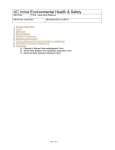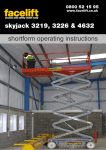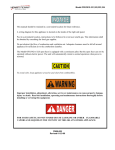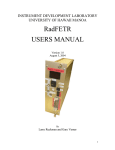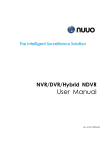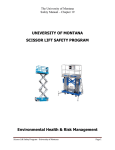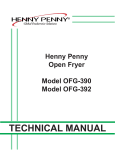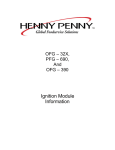Download 08 OFG Safety Program Manual - Operation of Aerial Platforms
Transcript
OPERATION OF AERIAL PLATFORMS 1. PURPOSE To outline the safe operating procedures of aerial platforms, aerial ladders, articulating boom platforms, vertical towers, ladder trucks, or a combination of such devices used to elevate OFG employees to job-sites above ground and to prevent serious accidents from occurring while operating these devices. This procedure applies to the above devices owned by the University of Hawaii at Manoa, or leased by the University of Hawaii at Manoa, which are operated by the Office of Facilities and Grounds (OFG). In addition to the requirements found within this section, additional requirements may be found in the OFG – Fall Prevention and Fall Protection Program. 2. DEFINITIONS Aerial Platform - A manually propelled, or vehicle mounted device that has an adjustable position platform, supported from ground level by a structure or vehicle. Authorized Personnel – OFG employees authorized to operate an aerial platform and assigned to perform a specific type of duty or duties at a specific location or locations at a work site. Base - The relevant contact points of the aerial platform that form the stability fulcrum (e.g., wheels, casters, outriggers, stabilizers, etc.) Chassis - The integral part of the aerial platform that provides mobility and support for the elevating assembly. Competent Person - An OFG employee who, due to training and experience, is capable of identifying hazardous or dangerous conditions in powered platform installations and is capable of training OFG employees to identify such conditions. Configuration - All positions in which an aerial platform or any part thereof can be placed within its intended operating limits. Elevating Assembly - The mechanisms used to position the platform relative to the aerial platform chassis. Guardrail System - A vertical barrier intended to prevent OFG employees from falling to lower levels. OFG - Operation of Aerial Platforms July 2011 Page 1 of 12 Revision 0 Hazardous Location - Any location that contains, or has the potential to contain, an explosive or flammable atmosphere as defined in ANSI/NFPA 505. Instability - The quality or state of being unstable, likely to tip over. Insulated Platform - A platform designed and tested to meet the specific electrical insulation ratings consistent with the Manufacturer’s identification plate. Interlock - A control or mechanism that, under specific conditions, automatically allows or prevents the operation of another control or mechanism. Lanyard - A flexible line or rope, wire rope, or strap which is used to secure the body belt or body harness to a deceleration device, lifeline or anchorage. Modification/Modified - To make a change(s), temporary or permanent, to an aerial platform that affects the operation, stability, safety factors, rated load or safety of the aerial platform in any way. Operator - A qualified person who controls the movement of the aerial platform. Outriggers - Devices that increase the stability of the aerial platform and that are capable of lifting and leveling the aerial platform. Platform - The portion of the aerial platform intended to be occupied by OFG employees with their necessary tools and materials. Platform Height - The vertical distance measured from the floor of the platform to the surface upon which the machine is supported. Qualified Person - An OFG employee who by reason of knowledge, experience, and training is authorized to use the equipment and is familiar with the operation to be performed and the hazards involved. Rated Work Load - The designed carrying capacity of the aerial platform as specified by the manufacturer. Shall - The word “shall” is to be understood as mandatory. Stability - The quality, state of being stable, firmly anchored, not likely to tip over. OFG - Operation of Aerial Platforms July 2011 Page 2 of 12 Revision 0 Stabilizers - Devices that increase the stability of the aerial platform but are not capable of lifting or leveling the aerial platform. 3. RESPONSIBILITIES Assistant Vice Chancellor for Campus Services - Responsible for the overall implementation of this procedure. OFG Departmental Directors for BGM and FMO - Ensure that the necessary training is acquired by all OFG employees performing maintenance or inspections on, working on, or operating aerial platforms/lifts, extensible boom platforms, aerial ladders, articulating boom platforms, vertical towers, ladder trucks, tower trucks, or any combination of such devices. OFG Maintenance Manager and Landscape Manager - Responsible to appoint an OFG Supervisor(s) or Lead Person(s) to serve as a Competent/Qualified Person(s), to ensure training for this/these position(s), and ensure that frequent and annual inspections are performed. The name(s) of this/these individuals shall be maintained by the Landscape Manager and the OFG Personnel Office. Maintenance and Landscaping Supervisor(s) - Ensure that all OFG employees assigned to this type of work are properly trained and authorized to perform the duties assigned. OFG Landscaping Office and the OFG Personnel Office - Responsible to ensure that all provisions of this procedure are kept updated according to the latest OSHA requirements, that training is available for OFG employees, and notifying management if written reports are not received. Also responsible for scheduling necessary training on this procedure, and maintaining training records. OFG Employees - Are not to operate any aerial platform without having been properly authorized for that piece of equipment and trained on the details of this procedure and the operating manual of the specific model aerial lift to be operated. 4. PROCEDURES a) ONLY AUTHORIZED (those who have been properly trained and authorized) OFG employees shall operate an aerial platform/lift, extensible boom platform, aerial ladders, articulating boom platforms, vertical towers, ladder trucks, tower trucks, or any combination of such devices. OFG - Operation of Aerial Platforms July 2011 Page 3 of 12 Revision 0 b) An OFG employee who is to serve as an Operator or a Worker who is to perform work from any aerial lift shall be trained on this procedure and on the operating manual of the specific device which is to be operated or work performed from. c) OFG employees who are scheduled to perform routine maintenance, inspections, or to repair any aerial lift shall have received training on this procedure and on the operating manual of the specific device PRIOR to performing any work on that device. Note: Operating and maintenance manuals should be obtained from the manufacturer of the aerial platform. d) A copy of this procedure, the operating manual, maintenance manual, and the log of inspections shall be kept with each aerial platform. These documents are considered an integral part of the aerial platform and are vital to communicate necessary safety information to users and operators. e) NO aerial platform shall be modified or altered without the modifications or alterations being approved and certified in writing by the Manufacturer or the Manufacturer’s representative. Records of all approved modifications and alterations, including written authorization from the Manufacturer or their representative for the modification or alteration, shall be kept with the aerial platform as part of the operating and maintenance manual. The altering or disabling of interlocks or other safety devices is prohibited. f) ALL MANUFACTURER’S SAFETY BULLETINS shall be complied with as received from the Manufacturer or Dealer and copies of these bulletins shall be kept with the aerial platform as part of the operating and maintenance manuals. g) MAINTENANCE - A preventive maintenance program shall be established for each aerial platform in use at the University, by the maintenance Supervisor responsible, in accordance with the Manufacturer’s recommendations and based on the environment and the severity of use of the aerial platform. h) MAINTENANCE SAFETY PRECAUTIONS - Before adjustments and/or repairs are started on an aerial platform, the following precautions shall be taken as applicable: i) The platform shall be lowered to the full down position, if possible, or otherwise secured by blocking and cribbing to prevent dropping. ii) All controls shall be in the “off” position and all operating features secured from inadvertent motion by brakes, blocks, or other means. OFG - Operation of Aerial Platforms July 2011 Page 4 of 12 Revision 0 iii) The power plant shall be stopped and “Locked Out” to prevent inadvertent starting. iv) Hydraulic oil pressure shall be relieved from all hydraulic circuits before loosening or removing hydraulic components. v) Safety props or latches shall be installed where applicable as described by the Manufacturer. vi) Any additional precautions specified by the Manufacturer shall be followed. i) REPLACEMENT PARTS - When parts or components are replaced, they shall be identical or equivalent to the original aerial platform parts or components. j) BEFORE OPERATION - Before authorizing an Operator to operate an aerial platform the Supervisor or appropriately trained lead person shall: i) Ensure that everyone who will be working on the aerial platform has been properly trained on this procedure, or the operating manual of the particular type of aerial platform to be used, and that this training has been properly documented. ii) Determine that the purpose for which the aerial platform is to be used is within the scope of the intended applications defined by the Manufacturer. iii) Provide approved fall protection devices and other safety gear for all OFG employees who will be working on the platform. iv) Check the area in which the aerial platform is to be used for possible hazards such as, but not limited to: 1. Drop-offs or holes. 2. Bumps or floor obstructions. 3. Debris. 4. Overhead obstructions and high voltage conductors. 5. Hazardous locations. OFG - Operation of Aerial Platforms July 2011 Page 5 of 12 Revision 0 6. Inadequate surface and support to withstand all load forces imposed by the aerial platform in all operating configurations. 7. Wind and weather conditions. 8. Other possible unsafe conditions. 9. Presence of unauthorized persons. k) PRE-START INSPECTION - Before use each day or at the beginning of each shift, the Operator shall visually inspect the aerial platform and conduct a functional test (a check list shall be utilized for this purpose) including but not limited to the following: i) Operating and emergency controls. ii) Safety devices. iii) Personal protective devices including fall protection. iv) Air, hydraulic, and fuel system leaks. v) Cables and wiring harness. vi) Loose and missing parts. vii) Tires and wheels. viii)Placards, warnings, and control markings. ix) Outriggers, stabilizers, and other structures. x) Guardrail system. xi) Items specified by the manufacturer. l) DURING OPERATION - The aerial platform shall be operated in accordance with this procedure. The Supervisor or Lead person shall direct the Operator to ensure the following before each elevation of the platform: i) That the aerial platform is operated on a surface within the limits specified by the Manufacturer. ii) That the outriggers, stabilizers, extendable axles, or other stabilizing methods are used as required by the Manufacturer. OFG - Operation of Aerial Platforms July 2011 Page 6 of 12 Revision 0 iii) That guardrail’s are installed and access gates or openings are closed per Manufacturer’s instructions. iv) That the load and its distribution on the platform and any platform extension are in accordance with the Manufacturer’s rated capacity for that specific configuration. v) That there is adequate clearance from overhead obstructions. vi) That the minimum safe approach distances (MSAD) to energized power lines and parts are maintained. (Ref. ANSI/SIA A92.3-1990.) vii) That all safety precautions defined in this procedure and the Operating and Maintenance Manual for the particular model of aerial platform being used are followed during the operation of the aerial platform. viii)That all OFG employees maintain a firm footing, with both feet, on the platform floor while working thereon. The use of planks, ladders, or any other device on the aerial platform for achieving additional height or reach is prohibited. ix) Special precautions shall be taken when other moving equipment or vehicles are present to comply with local ordinances or safety standards established for the workplace. Warnings such as but not limited to: flags, roped off areas, flashing lights, and barricades shall be used. m) REPORTING PROBLEMS OR MALFUNCTIONS - The Operator shall immediately report any problems or malfunctions that become evident during operation of the aerial platform to the Supervisor or Lead person. Any problems or malfunctions that affect the safety or operation of the aerial platform shall be repaired prior to continued use of the aerial platform. n) PRE-START, FREQUENT AND ANNUAL INSPECTIONS shall be performed by a trained maintenance OFG employee(s) or the Manufacturer’s representative. i) Pre-Start inspections shall be carried out as described in 4. k) above. ii) Frequent inspections shall be made, at a minimum, every six (6) months or five hundred (500) hours of operating time on all OFG aerial platforms. OFG - Operation of Aerial Platforms July 2011 Page 7 of 12 Revision 0 iii) An inspection meeting the criteria of a frequent inspection shall also be made prior to use if the aerial platform has been out of service for a period longer than three (3) months. iv) Frequent inspections shall be made by an OFG qualified (trained) mechanic that is familiar with the specific make and model of the aerial platform. v) The frequent inspection shall include all items specified by the manufacturer for a frequent inspection and shall include, but not be limited to the following: 1. All functions and their control for speed(s), smoothness, and limits of motion. 2. Emergency lowering mechanism. 3. All chain and cable mechanisms for adjustment and worn or damaged parts. 4. All emergency and safety devices. 5. Lubrication of all moving parts, inspection of filter element(s), hydraulic oil, engine oil, and coolant, as specified by the manufacturer. 6. Visual inspection of structural components and other critical components, such as fasteners, pins, shafts, and locking devices. 7. Placards, warnings, and control markings. 8. Items specified by the Manufacturer. 9. Correction of all malfunctions and problems identified and further inspection, if necessary, shall be performed before the aerial platform is returned to service. 10. Written documentation of all frequent inspections shall be kept with the aerial platform and a copy kept in the OFG Landscaping Office. vi) Annual inspections shall be made by a person qualified as a mechanic on the specific make and model of the aerial platform. The inspection shall include all items specified by the Manufacturer for an annual inspection. NOTE: This annual inspection is usually a part of the service contract on the aerial platform and is performed by a Manufacturer’s representative. OFG - Operation of Aerial Platforms July 2011 Page 8 of 12 Revision 0 vii) Aerial platforms that are not in proper operating condition shall be removed from service until repaired. A warning tag stating “UNSAFE DO NOT USE” shall be attached to the control panel of the aerial platform. viii) Written records of all inspections shall include the deficiencies found, corrective action taken, the date of the inspection and the date of the corrective action along with the name of the person(s) performing the inspection and the corrective action. Written records shall be kept with the aerial platform as part of the operating and maintenance manual and a copy maintained in the OFG Landscaping Office. o) ENTANGLEMENT - Care shall be taken to prevent rope, electric cords, hoses, etc., from becoming entangled in the aerial platform. p) CAPACITY LIMITATION - Aerial platform rated capacities shall not be exceeded when loads are transferred to the platform at any height. q) WORK AREA - The Operator shall ensure that the area surrounding the aerial platform is clear of personnel and equipment before lowering the platform. r) FUELING - The engine shall be shut down while fuel tanks are being filled. Fueling shall be done in a well-ventilated area free of flame, sparks, or other hazards that may cause fire or explosion. s) BATTERY CHARGING - Batteries shall be charged in a well-ventilated area free of flame, sparks, or other hazards that may cause fire or explosion. t) PLATFORM POSITIONING - The aerial platform shall not be positioned against another object to steady the platform. u) MIS-USE AS A CRANE - The aerial platform shall not be used as a crane. v) OPERATING AREA - The aerial platform shall not be operated from a position on trucks, trailers, railway cars, floating vessels, scaffolds, or similar equipment, unless the application is approved in writing by the manufacturer. w) TRAVEL CONDITIONS - Under all travel conditions, the Operator shall limit travel speed according to conditions of ground surface, congestion, visibility, slope, locations of personnel, and other factors causing hazards of collision or injury to personnel. OFG - Operation of Aerial Platforms July 2011 Page 9 of 12 Revision 0 x) UNAUTHORIZED USE - Means shall be used to protect against use by unauthorized person(s). y) SHUTDOWN OF THE AERIAL PLATFORM - The Operator shall cease operation of the aerial platform in case of any suspected malfunctions, any hazard, or potentially unsafe condition that may be encountered. The aerial platform and/or the work area shall then be inspected and any malfunction or problem shall be corrected before further operation of the platform. 5. TRAINING a) All OFG employees who are scheduled to perform the functions of Operators of aerial platforms or maintenance on aerial platforms shall have been trained on this procedure, either on the same model of aerial platform or one having operating characteristics and controls consistent with the one to be used during actual work site operation. b) Operator and maintenance training shall include, but not be limited to the following before actually operating the aerial platform or performing maintenance on an aerial platform: i) Know the intended purpose and function of each of the controls. ii) Read or have been instructed on and understand the manufacturer’s operating instructions, maintenance manual and safety rules. iii) Read or have been instructed on all decals, warnings, and instructions displayed on the aerial platform. iv) At the discretion of the OFG Competent Person either: 1. Can demonstrate competency through hands-on training and demonstrated knowledge of the equipment, or 2. Have completed a written test and passed it with a minimum score of 70%. Failure to achieve a passing grade will result in having to repeat the above three steps (i – iii) until a passing grade is obtained or the trainer, in consultation with the Supervisor, agree that this individual is not suited for aerial platform operation. v) In addition, OFG’s maintenance mechanic shall be instructed in performing frequent inspections (every six [6] months or 500 hours of operation, whichever occurs first) of all aerial platforms maintained by the UH Manoa OFG. OFG - Operation of Aerial Platforms July 2011 Page 10 of 12 Revision 0 c) The Operator trainee shall operate the aerial platform in an area free of obstructions under the direction of the qualified person for a time sufficient to determine that the trainee displays proficiency in knowledge and actual operation of the aerial platform. d) Only properly trained and authorized OFG employees shall be permitted to operate any aerial platform. e) Only properly trained OFG maintenance mechanic(s) shall be permitted to perform the frequent inspections and required maintenance of aerial platforms. f) Written records of aerial platform training for OFG Operators and maintenance mechanics shall include the OFG employee’s name, date of training, trainer’s name and affiliation, topics covered and the original written test or tests taken. These records shall be maintained for three (3) years by the Landscaping Office and the OFG Personnel Office. g) Re-training shall take place every three (3) years, or whenever a new model aerial platform is acquired or rented by OFG, or when an OFG employee demonstrates less than proficient operation or maintenance of aerial platforms. 6. RECORD RETENTION a) The following records shall be maintained for a minimum of three (3) years by the OFG Landscaping Office: i) Records of the OFG employees trained as operators of each model of aerial platform. ii) Records of each OFG employee trained to perform maintenance and inspections on each model of aerial platform. iii) Written records of the frequent and annual inspections by OFG on each aerial platform owned or rented by OFG (if rented for a period of time to require frequent or annual inspection, e.g. 500 hours operation or six months). These records shall include the date of the inspection, model and serial number of the aerial platform, name and affiliation of the person performing the inspection, any deficiencies found, and the corrective action recommended. OFG - Operation of Aerial Platforms July 2011 Page 11 of 12 Revision 0 iv) Written records of all repairs accomplished on each aerial platform owned or rented by OFG, including the date of the repair, a description of the work accomplished, the work order number, model and serial number of the aerial platform, and the identification of the person(s) performing the work. v) Written records of inspections, repairs, modifications, alterations, and statements of Manufacturer’s approval for any modifications and alterations shall be maintained for three (3) years after sale or other disposition of the aerial platform. OFG – Operation of Aerial Platforms Reviewed and Approved by: _____________________________ Assistant Vice Chancellor for Campus Services ______________________ Date OFG - Operation of Aerial Platforms July 2011 Page 12 of 12 Revision 0












